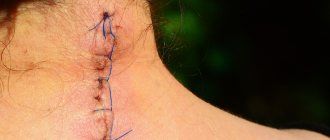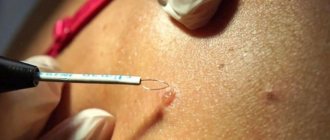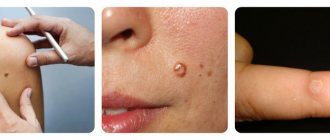Benefits of laser removal
Having decided to undergo laser removal of tumors, their owners ask questions about the safety of the method. What are the advantages over other methods?
- painlessness;
- efficiency;
- non-invasiveness (no exposure to surgical instruments - needles, scalpels, etc.);
- sterility;
- fast healing;
- minimum contraindications;
- no scars after surgery.
Modern technologies make it possible to control the process with millimeter precision, quickly getting rid of the tumor. The laser ensures rapid tissue regeneration and does not cause bleeding, reducing the chances of infection.
The procedure is becoming more popular than other methods. The cost of the operation will depend on the choice of medical institution. It is preferable to carry out the procedure in a clinic rather than with cosmetologists.
Removing moles on the face
The presence of formations on the face sometimes causes both aesthetic and physical discomfort. Located on the face, it is often injured, bleeds and causes pain. The presence of a large or uneven mole on the face sometimes makes you feel complex about your appearance.
Removing a mole from the skin of the face is the same as from other parts of the body. The neoplasm is examined, the patient undergoes consultation with doctors. Removal, depending on the size of the mole, takes from a few seconds to 5 minutes. In cases where the neoplasm is large, it will require removal in layers. Several days should pass between procedures.
The operation does not leave bruises or bruises, only a wound that will cover itself with a protective crust.
Removing red moles
Removal of angiomas is also possible using the laser method. Red vascular neoplasms cause inconvenience when large in size. The nature of their appearance and malignancy are also determined by doctors during the examination. If necessary, the patient is tested for the absence of diseases that may be contraindications for removal.
The removal and healing process is no different from removing a regular mole.
Photos before and after removal
Before surgery, many people are concerned about how the site will look after removal. Below are photos before and after surgery:
Despite the apparent pain of the procedure, it is performed under anesthesia. The healing process depends on following the recommendations of the attending physician and one’s own responsibility. The after photos are presented after the healing time has passed (from four months to a year).
Healing process
Immediately after the operation, a scar remains at the site of the mole. The doctor thoroughly disinfects it and gives recommendations for care. During the day after the procedure, a protective crust forms at the site of the mole. Under no circumstances should you get rid of it - it will promote healthy and rapid healing.
For several days after the crust has formed, it may be damp; the doctor will prescribe disinfectants to treat the affected area. The surrounding skin may begin to itch - this indicates the healing process.
Healing time directly depends on wound care, and it is strictly individual. With fast regenerating ability, the process will take two to three weeks, with slow regenerating ability, the process can drag on for months. To speed up the process, special care is required for the affected area.
How to treat a wound after removal
If a bleeding wound opens after removal, tell your doctor. After laser removal, a dry crust of skin should form; disinfectants should be prescribed by a doctor. When the crust falls off on its own, pink skin forms in its place. This will indicate healthy skin healing.
Prevention
As you can see, it is possible to remove a scar from mole removal, but it is much easier to prevent its appearance than to fight it later. Doctors highlight several basic recommendations that need to be followed:
- Care for the wound properly. After the nevi are removed, a wound remains in their place, which must be carefully and constantly cared for. For a week it cannot be wetted, and the crust cannot be peeled off, as mentioned above. If the doctor prescribes you means to treat a wound, you need to do it.
Consequences
If the operation is performed correctly and all doctor’s recommendations are followed, the healing process will accelerate. If a mole is not completely removed, serious skin problems can occur; this risk can be reduced by choosing an experienced specialist. The clinic must be equipped with modern technologies and have a good reputation.
If you do not follow the recommendations within three days after surgery, the skin may become inflamed. The process of treatment and healing of the wound in this case can take a long time. In addition, if you subject the skin to mechanical stress or try to get rid of the crust, a scar may remain. Prolonged exposure to ultraviolet light on an already healed wound, during the first four months, can lead to skin pigmentation. There is a risk of a new growth appearing in place of the old one.
If all conditions are met, the complete healing process will take four to six months.
Complications after removal
Complications depend on the size of the removed mole and the complexity of the operation. A large wound takes longer to heal, has a greater chance of developing inflammation, and the scar from it takes a long time to heal. When small moles are removed, the chances of complications are reduced. If the removal took place in several stages, and healing does not occur for a long time after the first operation, the doctor may suggest removing the remainder in other ways.
Complications can arise from incomplete removal of a mole or laser treatment of too deep layers of skin. Incomplete removal leads to the reappearance of the mole. Interference with its functioning, which led to incomplete removal, can lead to the development of a tumor. The new one is removed after the results of the first procedure have completely healed.
Sometimes complications in the form of inflammation or bleeding can occur in women experiencing hormonal problems. Before the operation, a qualified doctor prescribes all types of tests associated with the procedure.
If not properly cared for, pus will form at the scar site. You should not self-medicate; it is better to consult your doctor. A difficult healing process increases the chances of developing a non-healing scar on the skin.
Scars and scars after removal
After four months, a white, sunken surface or raised scar remains on the skin. If the healing process is favorable, the doctor may suggest products that help skin regeneration. If recommendations are not followed or rehabilitation is difficult, the scar may not heal for a long time.
If there are no neoplasm cells and the wound has completely healed, it is possible to visit a cosmetologist. Consult a doctor; laser scar correction can be performed to heal the scar. It takes at least a year for the scar to correct after surgery.
During the rehabilitation process after laser removal of a mole, it is important to follow all the recommendations of the attending physician, not expose the skin to ultraviolet radiation, and undergo regular examinations - this will help speed up the regeneration process.
If a mole is often injured, causes aesthetic problems, or has a tendency to malignant degeneration, removal is recommended. Thanks to the use of modern technologies, nevi are excised painlessly, the operation is quick, does not require hospitalization and rarely causes complications.
When a large growth is removed, an inflammatory process occurs and keloid scars may remain on the skin. The scar after mole removal may have a large diameter, dense structure, cause discomfort and create a cosmetic defect.
What does a keloid scar look like?
This neoplasm on the surface of the epidermis has its own characteristics:
- change in skin color over the scar;
- pain even after healing of the wound;
- sensations of itching, burning of the affected area;
- The size of the scar formed at the site of the wound gradually increases, affecting healthy areas of the skin.
In some cases, touching a keloid does not cause any discomfort. The growth of this neoplasm usually occurs in length, and sometimes branches appear on the sides, resembling claws in appearance.
Such symptoms cannot be ignored, and it is very important to promptly contact a specialist who will prescribe competent treatment or refer the patient to a surgeon to remove the colloidal scar.
Colloidal scars can be treated, but the process can be quite lengthy and requires a lot of patience. After all, if you do not complete the prescribed course of therapy, the keloid will continue to grow.
Treatment of these neoplasms is usually carried out in several ways:
- Drug therapy.
- Surgical removal of scars.
- Physiotherapeutic procedures.
- Pressure on the keloid using a tight bandage.
- Cosmetology procedures.
- Cryotherapy.
The method of using medications involves introducing hormonal medications into the colloidal scar, which help reduce collagen production and also reduce inflammation within the scar. Many patients are prescribed interferon injections to boost immunity.
Some specialists treat with hormonal ointments that promote the resorption of the keloid.
If there is a tendency to form colloidal scars after healing of the wound surface, a pressure bandage is usually applied, with the help of which it is possible to prevent tissue proliferation. This bandage cannot be removed for several months.
Physiotherapeutic methods include special massage, electrophoresis, physical therapy, magnetic and radiation therapy.
For hypertrophic keloid, in some cases, cosmetic procedures are effective: resurfacing, peeling, mesotherapy. The only condition here is to stabilize the condition of the scar and completely stop its growth.
A keloid scar is the result of an excessive increase in connective tissue that occurs at the site of skin fusion during the postoperative period.
Most doctors agree that the appearance of such scars is caused by a violation of the mechanism of connective tissue structure in the human body and excessive production of collagen.
Violation of the integrity of the skin is fraught with several types of scars:
Keloid scars are the result of the growth of skin tissue over the surface of a healing wound, which causes a tumor-like formation on the skin.
A keloid scar is a smooth formation with a dense structure and evenly defined edges. The growth has a red, bluish or purple tint, which is explained by the growth of small capillaries into the skin. The boundaries of the keloid are located far beyond the edges of the wound itself and differ sharply from the surrounding tissue.
Keloid scars can interfere with movement. This is a particularly common problem when a formation occurs in the area of a joint or facial muscles.
Mechanism of scar formation
After the wound heals, the epithelium is replaced by connective tissue, which is characterized by increased density and reduced functional properties. There are no hair follicles or sweat glands, and the cells are more susceptible to ultraviolet radiation.
Scars after removal of large moles can be hypertrophic or atrophic. The first type is characterized by excessive growth of collagen fibers; a convex scar occupies a larger area than the size of the former nevus, rises above the surface of the surrounding skin, and looks like a rounded nodule. Atrophic scars, on the contrary, cause tightening of the dermis, and less connective tissue is formed than was previously healthy.
The process of keloid formation begins 2 weeks after epithelization of the wound and continues for several years. During this time, it enlarges, becomes coarser, and changes color from bluish, red to light pink. After 2–3 weeks, the new tissue swells, becomes convex, causes itching, and painful sensations appear on palpation.
After a month, the severe discomfort goes away, the skin around the scar turns red. The scar becomes dense to the touch and acquires an uneven, bumpy surface. After a long period of time, the keloid may become soft or remain hard forever.
Treatment options
How to remove a scar at the site of a removed nevus? Cosmetic procedures, the use of special creams, or surgical excision of pathological tissue can help get rid of scars on the face and body.
Laser treatment techniques are widely used. When exposed to the skin, dense fibers are destroyed, the production of fibroblasts is stimulated, connective cells, in turn, contribute to the formation of new collagen, elastin, and smoothing of the dermis. After resurfacing, slight redness of the skin may appear, which goes away on its own after 3 days. The course of treatment consists of 4–5 sessions.
For greater effectiveness after laser therapy, it is useful to do dermabrasion, mesotherapy, facial peels, take physiotherapeutic procedures, and use EPI-DERM silicone film.
Traditional methods
Traditional medicine also did not stand aside, and you can try to get rid of scars using home methods. You can try the following options:
- Treat scars with masks. Use essential oils, apply mixtures of them twice a day for at least a month. For example, rose and tea tree oils are mixed in equal proportions with incense, and the mixture is applied to the place where there was previously a mole.
- You can even heal scars with cabbage leaves. This vegetable is known for its healing and anti-inflammatory properties. And all because cabbage leaves are rich in vitamin E, which regenerates the skin. The recipe is quite simple: chop 2 cabbage leaves and mix them with a tablespoon of honey. You need to make a compress from this mixture and apply it to the scar for two hours, twice a day, until it becomes less noticeable or disappears altogether.
Only a specialist can help you choose the appropriate removal method correctly.
Scar creams
You can improve the condition of the skin after removing moles with a laser or cauterization using medicinal ointments. Pharmacy products are used at home in the initial stages of scar formation. Absorbable and softening gels are most effective for shallow defects and are prescribed for complex treatment after laser resurfacing.
Creams for scars on the face and body:
- Contractubex has a softening, anti-inflammatory and smoothing effect on scar tissue, inhibits the growth of keloid feroblasts, relieves itching and irritation. The ointment helps remove atrophic and hypertrophic scars after mole removal. The gel is applied 2-3 times a day; for old scars, bandages are applied at night. Treatment is long-term and can take several months.
- Scarguard is a liquid cream made from hydrocortisone, silicone and vitamin E. The drug reduces inflammation, itching and swelling of tissues, and deeply moisturizes the skin. Tocopherol acts as an antioxidant, increases the elasticity of the epidermis, and stimulates cellular metabolic processes. The course of treatment is 1–6 months, the duration of therapy depends on how long ago the excision was performed.
- Kelo-coat is made from silicone. The drug prevents the formation and reduces the severity of scars, improves the aesthetic appearance of the dermis. After applying the gel, a protective film is formed that protects against the negative effects of external factors and liquid evaporation. The scars soften and gradually smooth out.
It is contraindicated to use pharmaceutical gels after removing nevi and moles without first consulting your doctor. It is necessary to take into account the possibility of side effects, individual intolerance, the patient’s age, the presence of skin diseases, and inflammation. The combination of cosmetic procedures and the use of creams for external use allows you to achieve more effective results.
A scar after removal of a mole is a mark on the skin, which consists of connective tissue and is formed when the wound that arose as a result of excision of the nevus has healed. The scar contains a large amount of collagen; the tissues have low functional capacity. The scar is not elastic and has no hair follicles or sweat glands. The stain removal mark is highly sensitive to ultraviolet radiation.
How to remove a scar
To prevent the appearance of scars or cicatrices, you should adhere to the following recommendations after removing a mole:
- Use ointments designed to smooth the skin.
- Injections of corticosteroids into the atrophic scar may be necessary.
- Perform physiotherapeutic procedures.
- Immediately after the operation, a bandage with absorbable components must be applied.
- You can resort to cosmetic procedures, such as resurfacing.
Any doctor’s recommendation is important; neglecting it will only delay the regeneration process.
In what cases does a scar remain?
Considering the painless factor of mole excision, removal methods should be used for the following reasons:
- the nevus is subject to constant mechanical damage;
- the location of the growth in a place where friction is increased (the area of the body where hair removal occurs, the bridge of the nose, shoulders, abdomen);
- nevus has a malignant form;
- the presence of aesthetic discomfort from a convex, hanging or large mole.
Scars can form in various parts of the body. There are several types:
- A hypertrophic scar after removal of a mole is distinguished by its elevation above the skin and does not have the ability to spread beyond the area where the nevus was located. After two to three years, the mark from the operation will level out and reach the skin level.
- An atrophic scar is presented in the form of a hole at the site where the mole was removed. The area of the body has a flabby surface.
- After removal of a mole, a keloid scar can rise above the skin level and extend beyond the area where the nevus was removed. Scars of this type are visible to the naked eye, they hurt and begin to itch.
- Normotrophic. The formation of a scar of this type is invisible to other people. It is flat and flesh-colored.
A scar occurs in 80 percent of cases. If the scar darkens, turns red or itches after mole removal, the following factors may be the cause:
- Injury to the place where the mole was removed or the skin around it was stretched. Mechanical impact will provoke the process of tissue proliferation. This may include uncomfortable and tight clothing or prolonged exposure to direct sunlight.
- Trying to get rid of the scar on your own.
- Increased levels of collagen production will lead to the development of excessive epidermal tissue.
- Changes in hormonal levels. A hormonal surge affects the metabolic process in the body, as a result of which connective tissue is formed incorrectly.
- The hereditary factor serves as the root cause if pathology occurs. If a man or woman has a colloidal scar, there is a high chance that their child will experience a similar phenomenon.
- Improper care of the wound surface. After removing the nevus, a protective crust forms. It may itch. It is forbidden to rip it off or comb it, as this increases the risk of infection entering the wound. The excision site will take longer to heal, and pathology will occur in the epithelial tissues.
What is a scar
As mentioned earlier, the procedure for removing a mole is simple. If a scar remains after mole removal, it can cause a lot of discomfort. First of all, it's ugly. If the mole was located in a visible place, the scar after mole removal will not look aesthetically pleasing. This question is especially acute for the fair half of humanity. If you do not take care of the scar in advance and do not ask a dermatologist about the possibility of its appearance, then the formation of a scar is inevitable.
What is a scar? This is a collection of a special type of connective tissue that forms at the site of surgery. Since human skin is multi-layered, such a growth stands out against the general background and becomes noticeable to others. Since it does not look like ordinary skin, both in appearance and to the touch (more convex).
If the scar is fresh, it is red-pink, since the inner layers of the skin do not have time to grow over the upper epithelium. Over time, the color changes first to blue, then it becomes less pigmented and becomes flesh-colored or whitish. A healed scar after mole removal can be seen in the photo.
Effective ways to get rid of a scar
Surgery during which a birthmark is removed is a serious procedure, so it is recommended to remove the formation not in a beauty salon, but in a specialized clinic. The doctor selects the method of excision individually, based on the characteristics of the nevus. The beauty salon provides laser nevus removal. In rare cases, a scar remains after removal of a mole with a laser, but nevi that are oncological in nature cannot be removed with a laser. It is recommended to entrust the excision of the spot to a surgeon, since improper surgical intervention results in a compaction that rises above the level of the skin.
If you have a question about how to remove a scar after removing a mole, avoid self-medication. It is advisable to visit a doctor who will prescribe medications that can get rid of the scar. This is required for those nevi that are located on the face, as the person’s appearance changes. Medical removal of scars is based on the use of cream, ointment, gel, which are applied to the place where the formation was located.
A popular medication is Contractubex. The gel has an anti-inflammatory and relaxing effect, restores the epidermis. Duration of use is at least three months. During this time, it is necessary to apply the gel to the area of skin where the stain was removed. Continue application until the scar completely disappears. Application time depends on skin and health.
An effective way to get rid of scars is dermabrasion. Mechanical peeling is based on grinding the area of skin where the growth was located. Sanding is done using a rotating brush. Dermabrasion eliminates scars in the upper layer of the skin, reducing the risk of deep scarring.
To eliminate the mark after excision of a nevus, injection of collagen or fat mass is necessary. The method is effective for small scars. The process is based on filling the area of skin with a scar with a special substance. After the procedure, the scar becomes almost invisible. In addition to eliminating scars, injection treatment involves rejuvenating the dermis and accelerating the recovery process. As a result of mesotherapy, the skin acquires an elastic, firm, toned appearance. The disadvantage of mesotherapy is the short duration of the effect. A month later, the injection must be repeated. This method is used less frequently than others due to its high price.
Laser removal stimulates the growth of a new layer of skin. To achieve the result, it is necessary to carry out three to four procedures, after which the scar will become less noticeable. Laser therapy is carried out using two methods:
- The impact of laser beams on blood vessels, the flat scar disappears.
- The laser beam heats the surface of the skin to remove the epidermis. The advantage of the method is that there is no risk of infection, and the time during which the skin recovers after therapy.
The surgical method of removing a scar after excision of a nevus is one of the most difficult. The surgical procedure using a scalpel involves sewing new skin onto the area where the growth was located. The method is time-consuming and expensive. Surgical removal is recommended if twelve months have passed since the birthmark was removed.
Where to go for help?
In fact, removing a mole is not as simple an operation as it might seem at first glance. It is better to get rid of them in specialized clinics, rather than in beauty salons:
- Firstly, any procedure to remove a mole violates the integrity of the epithelial tissue. That is, it causes a wound to appear;
- Secondly, the treatment method is selected taking into account the nature of the mole, its size, condition and depth of damage to the skin. For example, beauty salons most often offer to get rid of nevi using laser therapy. This method is indeed very effective - after the procedure, a scar or scar appears in rare cases. However, this method cannot remove moles of an oncological nature;
- Thirdly, the reason why a scar or keloid remains - a compaction of skin cells that rises above its surface - can be a violation of the surgical technique.
What method of mole excision does not leave scars?
Regardless of which method was used to remove the growth, there should be no trace left. There are cases where a colloidal scar occurs due to the excessive appearance of new skin cells in the wound. The reason for this is a violation of excision technology or epidermal pathology. Electrocoagulation, which affects the formation of high-frequency current, leaves a small scar. If the operation is performed correctly, the scar is almost invisible.
Excision of a birthmark using a scalpel is based on the removal of the birthmark and healthy skin. After the procedure, the doctor puts a suture, which leaves a scar. There are no traces left during cryodestruction. The condition is not the facial location of the nevus. This is explained by the fact that liquid nitrogen will damage healthy skin.
Treatment methods for scars after moles
There are many ways to get rid of it. If the removal was performed surgically and stitches were applied, scars cannot be avoided. The effectiveness of the operation depends on the professionalism of the doctor and the chosen technique. The choice of treatment method for scars depends on how long ago they appeared and their appearance.
Medication
To improve the condition of the skin after eliminating the nevus, medicinal ointments are used. The drugs are used at home at the time of formation. Ointments for resorption and softening are effective for shallow scars.
Among the popular and effective ointments are:
- Contractubex ointment. Softens the wound covering, acts as an anti-inflammatory, smoothing agent. Relieves itching and irritation.
- Skarguard cream. Relieves inflammation, itching and swelling, moisturizes.
- Gel Kelo-coat. Made from silicone. Can reduce the appearance of scars and improve the appearance of the skin.
If the use of ointments is combined with cosmetic procedures, the result will be achieved in a short time.
Physiotherapy
The formations can be removed with physical therapy.
Description of the procedure:
- By affecting the blood vessels, shallow scars are eliminated.
- A deep scar is removed using a laser: the surface of the skin is heated, connective tissue cells are melted, and the stain is removed.
Laser stain removal is considered the most effective. After manipulation, there are no signs of stains left on the skin.
In modern cosmetology, the issue of removal is resolved quickly. If the scars are large, cosmetologists recommend using a mechanical method of scar removal.
Radiation therapy
Experts have different opinions. Most doctors prescribe radiation therapy individually for each patient. The effectiveness of such treatment is influenced by the location of the scar (face, nose, arm, leg), size, and depth. The specialist’s task during the procedure is to achieve uniform radiation and dose over the entire surface without touching healthy tissue.
Cosmetic procedures
Dermabrasion involves grinding the surface and removing the formation layer by layer. The technique is aggressive, but effective. To completely erase it, two therapy sessions are enough.
Electrocoagulation
Electrocoagulation is used to remove the scar. It involves the use of high-frequency current, acting as a scalpel. Due to the periodicity of discharges, the surface of the stain is cut and removed in small layers. The procedure is carried out under the influence of heat, the blood vessels do not bleed and are cauterized, thereby reducing the risk of infection. Performed immediately after removal of a mole. During manipulation, the surface is numbed with nitrogen, which freezes the skin. The period of one session is 15 minutes.
Comments
- megan92 () 2 weeks ago
Has anyone managed to get rid of papillomas in their armpits? They really bother me, especially when you sweat.
- Daria () 2 weeks ago
I have already tried so many things and only after reading this article, I was able to get rid of papillomas in the armpits (and on a very budget). PS But I’m from the city myself and didn’t find it on sale here, so I ordered it online.
- megan92 () 13 days ago
Daria, post a link to the article! PS I'm from the city too))
- Daria () 12 days ago
megan92, that’s what I wrote in my first comment) I’ll duplicate it just in case - a link to the article.
- Sonya 10 days ago
Isn't this a scam? Why do they sell on the Internet?
- Yulek26 (Tver) 10 days ago
Sonya, what country do you live in? They sell it on the Internet because stores and pharmacies charge outrageous markups. In addition, payment is only after receipt, that is, they first looked, checked and only then paid. And now everything is sold on the Internet - from clothes to TVs and furniture.
- Editor's response 10 days ago
Sonya, hello. This drug for the treatment of papillomavirus infection is indeed not sold through pharmacy chains and retail stores in order to avoid inflated prices. As of today, you can only order on the official website. Be healthy!
- Sonya 10 days ago
I apologize, I didn’t notice the information about cash on delivery at first. Then everything is fine if payment is made upon receipt.
- Margo (Ulyanovsk) 8 days ago
Has anyone tried traditional methods to get rid of warts and papillomas?
- Andrey A week ago
I tried to burn off a wart on my head with vinegar. The wart really went away, only in its place there was such a burn that my finger hurt for another month. And the most annoying thing is that after a month and a half, two more warts popped up nearby ((
- Ekaterina A week ago
I tried to burn out the papilloma with celandine, but it didn’t help, it just turned black and became so scary (((
- Maria 5 days ago
I recently watched a program on Channel One, they also talked about this PAPIFEX. Many doctors recommended for treatment. I ordered it, I use it, and indeed, the papillomas are dissolving one by one, there are only 2 left, the most tenacious ones.
- Elena (dermatologist) 6 days ago
Maria, soon these two will disappear too!
- Alexandra (Syktyvkar) 5 days ago
A good product, completely worth the price. I have never seen any analogues.
- Maxim Today
Has anyone tried to reduce papillomas with liquid nitrogen?
- Tatyana (Ekaterinburg) Today
Yeah, you burn one, after a month three more grow ((I don’t recommend liquid nitrogen, although hospitals often use it
- Elena (dermatologist) 6 days ago
Tatyana, liquid nitrogen is a thing of the past, now PAPIFEX is used in full and there is no need to go to the doctors!
- Mikhail (Moscow) Today
PAPIFEX also helped (I ordered it according to the advice above), it should work, try it
- Vika (Ekaterinburg) Today
That's great! I need to order, otherwise I’m already tormented with these warts! After all, a woman always wants to be beautiful!
- Kristina (Minsk) Today
I had papillomas removed with a laser, quickly and without pain. But it's damn expensive.











